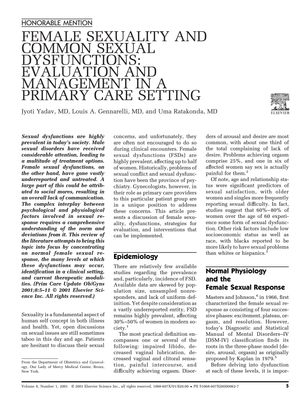Female Sexuality and Common Sexual Dysfunctions: Evaluation and Management in a Primary Care Setting
January 2001
in “
Primary Care Update for Ob/gyns
”

TLDR Primary care doctors should address female sexual dysfunctions to improve women's sexual health and life quality.
The document from 2001 addresses the issue of female sexual dysfunctions (FSDs), which affect 30%-50% of women, with arousal and desire disorders being the most prevalent. It points out that FSDs have been less studied and treated compared to male sexual disorders, often due to societal attitudes and poor communication. The paper outlines the physiological phases of the female sexual response and the various factors that can impact sexual function, such as hormonal changes, medical conditions, and medications. It also categorizes FSD into four types according to the DSM-IV: sexual desire disorders, sexual arousal disorders, orgasmic disorders, and pain disorders, with hypoactive sexual desire being the most common, affecting about 40% of patients in therapy. The document suggests that primary care physicians, particularly gynecologists, play a crucial role in the evaluation and management of FSDs using the PLISSIT model and discusses potential medical therapies, including hormone replacement and experimental treatments. The conclusion stresses the importance of addressing FSD in primary care to enhance women's sexual health and overall quality of life.
